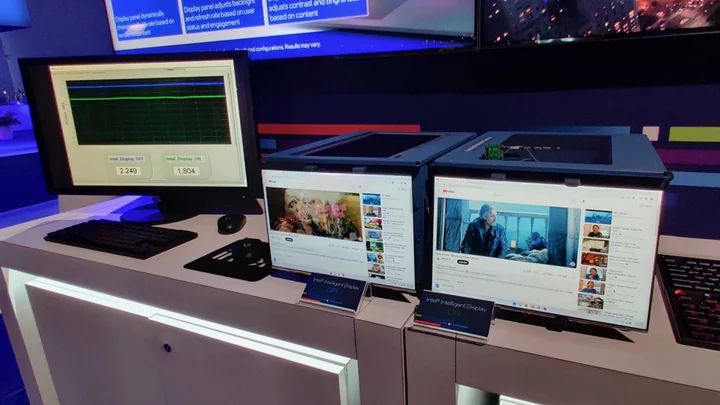One of the biggest energy-draining components on a laptop is the display. To cut down on the power consumption, Intel has created a system that can automatically turn off the laptop’s screen when you’re not looking, and switch it back on when you need to use it.
The power-saving approach is part of what it calls Intel Intelligent Display technology, which can use a variety of tricks, like lowering the refresh rate and brightness, to reduce the power draw from a laptop's display. The company demonstrated the technology today on the show floor at the Intel Innovation event in San Jose, Calif.
It’s no secret that lowering a display’s brightness or dialing down its peak refresh rate can extend a laptop’s battery life. The problem is that it forces you to settle for a compromised experience. In contrast, Intel’s solution can dynamically adjust the laptop’s screen, without making you sacrifice on image quality.
(Credit: Michael Kan)For example, Intel’s Intelligent Display tech includes a so-called “user-based refresh rate.” Once enabled, it can use the laptop’s camera to detect if you’re facing the computer or not. If the camera sees that your face has turned to the side, it’ll lower the display's brightness and refresh rate. And if it detects you’ve turned your back to the laptop, the screen will fully shut off, saving even more electricity.
To cut down power usage even more, the Intelligent Display tech can also lower the screen’s refresh rate to match the kind of content onscreen and what it needs. (An example: You’re in a video call that runs at 30 frames per second, which will not benefit from a faster refresh rate.) On top of this, the system can also lower the screen's contrast and brightness to complement the content, like for a particular movie scene.
(Credit: Michael Kan)Together, the power-saving functions can cut down on a laptop’s battery usage by up to 24%, according to Intel's estimates. If the user-based refresh rate is allowed to trigger the PC’s modern standby mode, power savings could reach as high as 42%.
Intel notes that the technology is not powered through the CPU silicon, but through a chip embedded in a compatible display. The chip is also compatible with the laptop's graphics driver. Intel is working on bringing the technology to PC makers for a variety of display types, including OLED, LCD and mini LED panels.
Expect the Intel Intelligent Display technology to arrive in December in the first laptops built around Intel's new “Meteor Lake” Core Ultra chips and in future chip generations. Intel says that for now, implementing the system is pricey, however, so only premium laptops will carry it at first.

